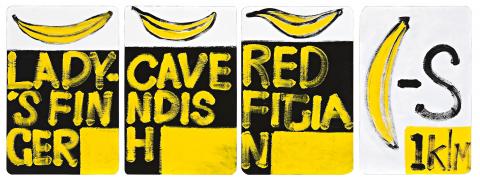MAYFAIR: RED FIJI, FOUR SIGNS FOR KL, 1993
ROBERT MACPHERSON
synthetic polymer paint on composition board, four panels
92.0 x 61.0cm each, 92.0 x 244.0 cm overall
panel 1 signed with initials and inscribed verso: 1 4/93 / RM
panel 2 inscribed verso: 11
panel 3 inscribed verso: 111
panel 4 signed with initials, dated and inscribed verso: 4’93 IV / 4 PANELS / RM
Yuill/Crowley, Sydney
The Collection of Colin and Elizabeth Laverty, Sydney, acquired from the above
Robert MacPherson, Mayfair, Yuill Crowley Gallery, Sydney, 1993, 9 October – 10 November 1993
Thomas, D., ‘Everybody Sing. The Art of Robert MacPherson’, Art and Australia, Sydney, vol. 33, no. 4, 1996, pp. 494 (illus.), 495
Heralded by René Block in 1990 as one of only two contemporary inheritors of the legacy of French revolutionary artist Marcel Duchamp, Robert MacPherson was a surprising addition to Australia’s cultural landscape.1 MacPherson, an autodidact from the tropical hinterland of Nambour in Queensland arriving late into the art world in the 1970s, is now considered one of the finest conceptual painters in Australia, producing works that combine the rigid teachings of Greenbergian formalism with philosophy and satire.
Mayfair: Red Fiji, Four Signs for K.L., 1993, brightly exhibits MacPherson’s appreciation for the quirks of language, carefully selected to resonate with Australian audiences. This multi-panelled painting was featured within the artist’s solo exhibition Mayfair at Yuill Crowley in 1993, a show prosaically named after the Art Deco sandwich bar in suburban Brisbane where the artist used to eat lunch. In 2015, the Queensland Gallery of Modern Art (QAGoMA) staged a significant retrospective of this artist’s work, featuring sister works from this series. Known collectively as road sign paintings, these artworks by MacPherson all feature text appropriated from vernacular and utilitarian advertisements lining the arterial highways of inland Australia. Painted on standard issue masonite, Mayfair: Red Fiji displays the names of popular types of bananas grown in Queensland and Australia - Cavendish and Ladyfingers - scrawled in disjointed bright yellow letters on a black background. MacPherson’s choice of colour is not insignificant – it provides another avenue for the artist to interrogate the relationship between the signifier and the signified, the name and the object, with the colour being representative of the object simply by association. Furthermore, black-and-yellow reflective signage is particularly evocative of our local milieu, favoured for its ability to attract attention and remain visible within our sun-scorched landscape. Other notable Australian artists have also been quick to use this visual device for their own practice, the most famous perhaps being Rosalie Gascoigne.
MacPherson’s work records how language and image shape human interaction with the physical landscape. An art that reveres text as much as image, MacPherson’s work uses letters that form a string of incidental text, the sense of which is not immediately visible to a cursory glance. There is instead an aesthetic rhythm in his succession of letters. Mayfair: Red Fiji reads LADY - / ‘S FIN / GER / CAVE/ NDIS/ H. / RED / FIGIA/ N / -S / 1 KM, containing seemingly plausible spelling errors and a frieze of Warholian bananas drawn above each name signifying the visual appearance of the product. The series ends abruptly with a vertically oriented panel, jarring the readers’ consciousness into recognising the produce will be available at a location 1 kilometre away, much in the same way as a sequence of road signs gradually displays decreasing indications of distance before a landmark. Showing the artist’s love of sequence and of the arbitrary nature of taxonomy, Mayfair: Red Fiji is a humourous aside, elevating the experience of the humble Australian. The dedication embedded in the title of this work adds a human touch to MacPherson’s dry conceptualism, K.L. being the initials of a former colleague, plucked from the artist’s blue-collar past and anonymously inserted into the whitewashed contemporary gallery.
While initially presenting itself as obscure, MacPherson’s work contains layers of cultural references, visual puns, linguistic double-entendres, creating a playfulness that rewards those who look beyond the surface of conceptual art.
1. René Block, French curator of the Sydney Biennale in 1990, Ready-made Boomerang, famously categorised MacPherson as a second-generation Duchampian Marxist artist.
LUCIE REEVES – SMITH
